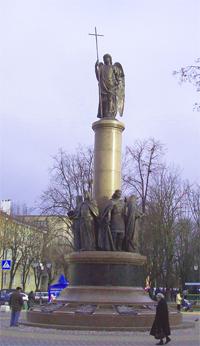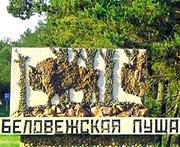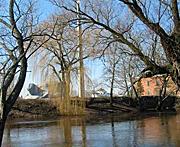|
Dear Ladies and Gentlemen!
 Brest Region is Belarus western gate, the center of Belarusian Polesye and it is situated in the center of Europe at the crossroad of busy roads from East to West and from North to South. Its territory occupies 32 700 square kilometers. The population is 1.5 million people. Brest Region is also known outside Belarus for The Brest Fortress, «Belovezhskaya Pushcha» for its rail and auto main road line that join Western and Eastern Europe. Brest Region is Belarus western gate, the center of Belarusian Polesye and it is situated in the center of Europe at the crossroad of busy roads from East to West and from North to South. Its territory occupies 32 700 square kilometers. The population is 1.5 million people. Brest Region is also known outside Belarus for The Brest Fortress, «Belovezhskaya Pushcha» for its rail and auto main road line that join Western and Eastern Europe.
Brest Region, or as it is also called the Beresteyshchyna, is the land of beautiful nature. There are hillocks and valleys cut by small rivers and covered with deep forests in North. There are many attractive valleys decorated with mirrors of lakes in the middle and eastern part of the region. The Brest region has about 80 small and large rivers with the total length of 5 000 kilometers.
In the north-west of the region there is a unique memorial of nature with extensive hunting areas, one of the oldest forest reserves in Europe. It is called The National Park «Belovezhskaya Pushcha». It is a natural habitat of aurochs, deer, wild boars, elks, wild goats and beavers.
«Belovezhskaya Pushcha» is a unique green pearl, the only large forest with virgin nature on the European Continent. The National Park has the status of biosphere reserve and the diploma of the European Council.
The history of towns and villages of the Brest region is rich and complex. Brest was first mentioned in 1019.
Every district centre of the Brest region has its own characteristic history. Stolin, Kamenets and Kobrin were first mentioned in the chronicles of the 12th - 13th centuries. Ivanovo, Pruzhany, Drogichin and Beryoza begin their chronology from the 15th century. Ivatsevichy, Luninets, Lyakhovichy and Malorita are only one century younger than the latest ones are. The origin of Baranovichy is connected with the construction of a railway in the second half of the 19th century.
People of Brest Region respect the architectural memorials. Bratskaya and Semenovskaya Churches in Brest, Pokrovskiy Cathedral and Krestovozdvizhensky Catholic Cathedral in Baranovichy, Varvarinskaya Church, the collegium of Jesuits, the monastery of
Franciscans in Pinsk. It is difficult to imagine the town of Kamenets without its famous «Kamenets Tower».
«The Brest Fortress is a real symbol of Brest. Built in 1842, the Fortress is an original example of the fortification art of that time. Meanwhile the Fortress got its real glory in 1941 when its garrison demonstrated military valor, mass heroism and courage in the struggle against fascist invaders. The Brest Fortress was awarded an honorary title of «Fortress-Hero». On September 25, 1971 «The Memorial Complex Brest Fortress Hero» was opened.
 In 1982 after excavations the archeological museum «Berestye» was found on the territory of the Fortress. In this museum the original ancient buildings of the 10th century are preserved. A special original glass roof was made above them. In 1982 after excavations the archeological museum «Berestye» was found on the territory of the Fortress. In this museum the original ancient buildings of the 10th century are preserved. A special original glass roof was made above them.
There are many memorial places connected with such famous people as Adam Mitskevich, Napoleon Orda, Kazimir Lyshchinskiy, Tadeush Kostiushko, Mikhail Oginsky and others in the Beresteyshchina. Twice-Hero of the Soviet Union, astronaut Peter Climuk is our fellow-countryman.
Brest is the beginning of White Russia, people often come to see preserved Slavonic site of ancient settlement of 11th century. But Brest Region is also interesting in modern aspect too; Brest region is also famous for its production potential, promising from the point of view of social-economic development.
The role of «M1/E30» road that joins Berlin – Warsaw – Brest – Minsk – Moscow is important.
There are two airports on the territory of Brest region. Airport situated in Brest city has international status and it is able to operate all kind of aircrafts.
Brest Region has two modern check-points at Belarusian-Polish border on its territory. There are also check-points at Belarusian-Ukrainian border.
The advantage of Brest Region's position becomes stronger because of Poland's integration to the European Union.
The scientific potential of the region is mostly oriented on the applied research. The institutions of higher education deal with research in the spheres of biology, sewage disposal and the development of new types of building materials.
There are about 330 industrial enterprises with an annual external output surpassing a billion US dollars on the territory of the region. The leading part in the industrial production belongs to food industry and mechanical engineering complex. Private businesses make over 65 percent of the total.
At present, more than 10 percent of the Republic's volumes of the industrial products are produced in the region. Besides, Brest has monopoly in the production of gas-stoves, electric bulbs and metal-cutting instruments. Almost half of the Republic’s volume of carpets, hosiery, woodworking plates and one third of sugar, cheese and facing slabs are produced in Brest Region.
 A great variety of the industrial-technical products is made in the region, including technical equipment for textile, meat and milk industry, public catering and trade; automatic lines, press-forging equipment, radio electronics products, AC electric motors, varnish materials and etc. A great variety of the industrial-technical products is made in the region, including technical equipment for textile, meat and milk industry, public catering and trade; automatic lines, press-forging equipment, radio electronics products, AC electric motors, varnish materials and etc.
The largest exporters are: Joint Venture Open Stock Corporation «Brestgazoapparat» (gas-stoves); Closed Stock Corporation «Pinskdrev» (plywood, matches); Baranovichy Machine Accessory Plant «Atlant» (compressors for fridge); Open Stock Corporation «Polesye» (hosiery, yarn); Baranovichy Cotton Production Amalgamation (textile, yarn); Open Stock Corporation «Zhabinka Sugar Plant» (white sugar); Open Stock Corporation «Pinsk Plant of Imitation Leather» (imitation leather, oil-cloth); Open Stock Corporation «Brest Carpets» (carpets); Unitary Enterprises «Granit» (crushed stone).
The industrial potential of the region enable an immediate answer to wide demands of consumer market and increases production value. Brest Region has overcome 1991-1994 crises and now its industrial production rate grows.
The agriculture of the region is specialized in meat and milk stock raising but at the same time the production of sugar beet, flax fiber, vegetables and potatoes is highly developed. Due to the mere use of the production powers of large stock-raising complexes of the region, Brestchina is apt to produce about 35000 tones of beef and 47000 tones of pork. In general, the use of the production powers makes it possible to produce more than 250000 tones of meat and about one million tones of milk in the public sector. It fully covers the requirements of the region in stock-raising products and makes it possible to create export reserve.
The construction complex is also highly developed in the Brest region. Construction enterprises produce different technical products such as lime, bricks, reinforced concrete constructions, ceramic facing tiles, non-metallic building materials.
 The largest deposit of granite is located on the region's territory and it is used in the production of crushed stones (Mickashevitchi). Unique deposits of clay can be found in Stolyn District. This makes it possible to produce bricks with frost-resisting up to 100 cycles. The Belarus' largest deposit of chalk is in Malorita district, it has about 500 millions tones of chalk in supply. The stripping of this open pit is of clear quartz sands used in general construction purposes The largest deposit of granite is located on the region's territory and it is used in the production of crushed stones (Mickashevitchi). Unique deposits of clay can be found in Stolyn District. This makes it possible to produce bricks with frost-resisting up to 100 cycles. The Belarus' largest deposit of chalk is in Malorita district, it has about 500 millions tones of chalk in supply. The stripping of this open pit is of clear quartz sands used in general construction purposes
More than 500 private businesses with foreign investments are registered in the region. The Free Economic Zone «Brest» was created in 1996. There are more than 90 enterprises registered as a residents in it, 70 percent of them have foreign investments. The investors consider food industry, woodworking and transport service to be the most attractive economic fields. The largest investments came from Russia, Italy, Germany, Poland and Czech Republic.
Brest Region is a member of «Cross-Border Association Euroregion BUG», which includes also Lublin Province (Poland) and Volhynia District (Ukraine) from 1998. The main aim incorporated in the Articles of the Association is to develop and expand the cross-border co-operation.
There is always a vacant place for those who can foresee and invest the success in all branches of agriculture in the region. Those who can use our region's offers will be always on top in business.
The Brest gate is always opened for cooperation. |
|
 Áðåñòñêàÿ îáëàñòü
Áðåñòñêàÿ îáëàñòü  Áðåñòñêàÿ îáëàñòü
Áðåñòñêàÿ îáëàñòü